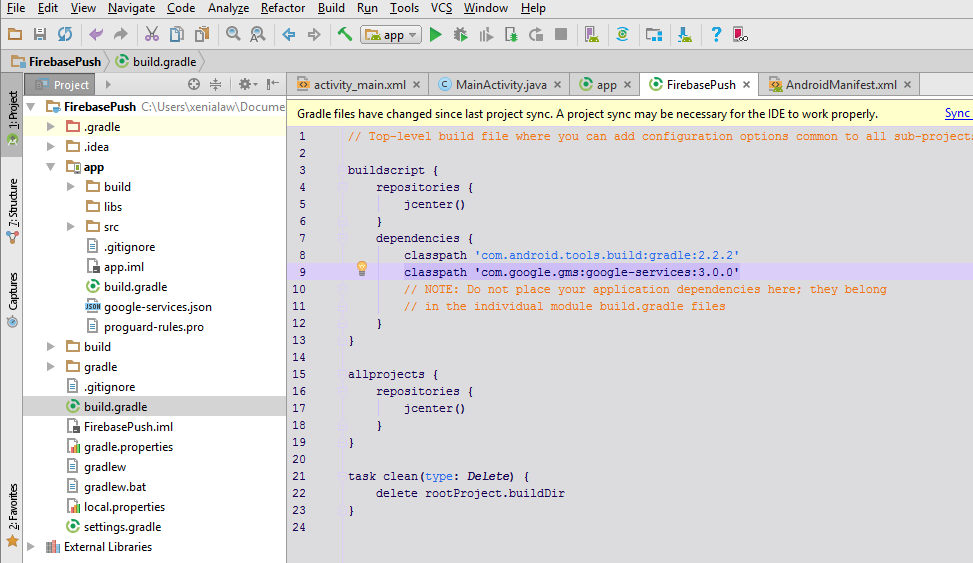Previous article:
[Tutorial] Firebase Android project push notifications on window platform - part1
Step 8
download your firebase google-services.json by clicking the button "google-services.json" and paste it to your android /app directory in your android project.
Step 9
Add rules to your root-level build.gradle file, to include the google-services plugin:
dependencies {
classpath 'com.android.tools.build:gradle:2.2.2'
classpath 'com.google.gms:google-services:3.0.0'
// NOTE: Do not place your application dependencies here; they belong
// in the individual module build.gradle files
}
Step 10
And then add the apply plugin line at the bottom of the file to enable the Gradle plugin in your module Gradle file (usually the app/build.gradle):
dependencies {
compile fileTree(dir: 'libs', include: ['*.jar'])
androidTestCompile('com.android.support.test.espresso:espresso-core:2.2.2', {
exclude group: 'com.android.support', module: 'support-annotations'
})
compile 'com.android.support:appcompat-v7:24.2.1'
compile 'com.google.firebase:firebase-core:9.6.1'
compile 'com.google.firebase:firebase-messaging:9.6.1'
testCompile 'junit:junit:4.12'
}
Step11
click "Sync now" and wait for sync
Step12
Add a class FirebaseInstanceIDService to your project extends FirebaseMessagingService with the code show below to display notification from firebase.
package com.firebasetest.firebasepush;
import android.app.NotificationManager;
import android.app.PendingIntent;
import android.content.Intent;
import android.support.v4.app.NotificationCompat;
import android.util.Log;
import com.google.firebase.messaging.FirebaseMessagingService;
import com.google.firebase.messaging.RemoteMessage;
public class MyFirebaseMessagingService extends FirebaseMessagingService {
private static final String TAG = "FCM Service";
@Override
public void onMessageReceived(RemoteMessage remoteMessage) {
// TODO: Handle FCM messages here.
// If the application is in the foreground handle both data and notification messages here.
// Also if you intend on generating your own notifications as a result of a received FCM
// message, here is where that should be initiated.
//super.onMessageReceived(showNotification(remoteMessage.getData().get("message")));
Log.d(TAG, "From: " + remoteMessage.getFrom());
Log.d(TAG, "Notification Message Body: " + remoteMessage.getNotification().getBody());
showNotification(remoteMessage.getNotification().getBody());
}
private void showNotification(String message) {
Intent i = new Intent(this,MainActivity.class);
i.addFlags(Intent.FLAG_ACTIVITY_CLEAR_TOP);
PendingIntent pendingIntent = PendingIntent.getActivity(this,0,i,PendingIntent.FLAG_UPDATE_CURRENT);
NotificationCompat.Builder builder = new NotificationCompat.Builder(this)
.setAutoCancel(true)
.setContentTitle("FCM Test")
.setContentText(message)
.setSmallIcon(R.drawable.ic_launcher)
.setContentIntent(pendingIntent);
NotificationManager manager = (NotificationManager) getSystemService(NOTIFICATION_SERVICE);
manager.notify(0,builder.build());
}
}
Step 12
Add MyFirebaseMessagingService.java as a service in your AndroidManidest.xml file.
<service android:name=".MyFirebaseMessagingService">
<intent-filter>
<action android:name="com.google.firebase.MESSAGING_EVENT"/>
</intent-filter>
</service>
Continue :
[Tutorial] Firebase Android project push notifications on window platform - part3






No comments :
Post a Comment